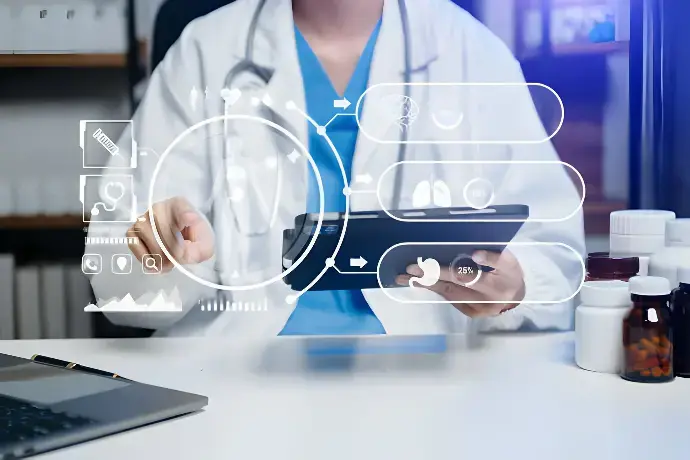Machine Learning and Integration in Healthcare Services
Revolutionizing Patient Care
In the ever-evolving landscape of healthcare, technology is not merely an adjunct but a cornerstone of progress. One of the most transformative technologies that have gained prominence is the integration of machines and software into healthcare services. This has ushered in a new era of an efficient and a data-driven patient care. Electronic medical device manufacturers are taking a solid place in the engineering market and technologies are taking more space in the modern medical workflow. This growing tendency can be observed in such examples as the use of virtual reality applications as a method for treating patients and the implementation of the electronic medical records (EMR) in hospitals and healthcare organizations. IoT encompasses the network of interconnected devices and sensors that can collect and exchange data. In the context of healthcare, this means that medical devices, wearables, and even hospital equipment can communicate with each other and healthcare providers in real-time. Following are some of the key points that highlights the various aspects of machine integration in today’s healthcare services and systems


Enhancing Patient Monitoring
Remote patient monitoring has been revolutionized by the integration of machines and software into healthcare services. Patients with chronic conditions can now wear devices that continuously track vital signs like heart rate, blood pressure, and glucose levels. These devices transmit data to healthcare providers, enabling proactive care and early intervention. For instance, if a patient’s heart rate spikes unexpectedly, healthcare providers can receive an alert and take immediate action.
Streamlining Healthcare Operations
Machine integration is not limited to patient care; it extends to optimizing hospital operations. Hospital equipment, such as MRI machines and X-ray devices, can beconnected to the IoT network. This connectivity allows for real-time monitoring of equipment status, ensuring that maintenance and repairs are conducted promptly,minimizing downtime and improving patient care.


Enhancing Telemedicine
Telemedicine has gained prominence, especially in the wake of the COVID-19 pandemic. Healthcare-related machines and connectivity with other software devices play a significant role in supporting telemedicine services. Wearables and home monitoring devices enable patients to transmit their vital signs and healthdata to healthcare providers during virtual consultations. This data provides a more comprehensive view of the patient’s health and aids in diagnosis and treatmentplanning.
Integrated workflow and complete automation
With medical device integration, the hospital receives an efficient, easy, and understandable workflow. All the sections of the hospital are connected, and due to the web-based system, they can be easily controlled.
One more contribution, to ease the daily routine of the medical staff, is eliminating the manual work with health records and clinical data. As it was mentioned above, now there is no need for collecting the data manually, since the integrated medical equipment is able to collect and analyze the data automatically. So, as a result, the medical personnel will receive clear and processed information, probably even collected and summed up from more than one device at a time. With integrated medical data, the process goes way faster, increasing its quality and eliminating all the possible errors due to human factors.


Remote control
With advanced machine technology & integration, doctors can watch over the health status of each patient even if they aren’t physically at the hospital. And what is more, patients are also able to check the information about their health (doctor’s conclusions, analysis results, drug prescriptions) without going to the hospital. It can be possible due to the cloud-based online access to the information and the personal cabinet.
Cloud-based Storage
The received data from all the medical devices will now be filtered, stored, and secured online. This means that there is no more struggle with searching for the required patient’s data through all the devices and the system will collect everything automatically and send the data directly to the place of storage. In addition, by using such a system, data will remain crack-proof.


Challenges and Opportunities
While machine integration offers immense potential in healthcare, it also presents challenges. Interoperability remains a hurdle, as devices and systems from different manufacturers must seamlessly communicate. Additionally, the vast amount of data generated by IoT devices requires sophisticated data analytics tools to extract meaningful insights.
But for us at Intulogic, these challenges represent opportunities. Our expertise in machine integration and healthcare solutions can help bridge the interoperability gap and develop analytics platforms that enable healthcare providers to harness the full potential of healthcare technology.
The Future of Healthcare: AI-Driven Healthcare Solutions
As AI and related technologies continue to evolve, it will become increasingly integrated into the fabric of healthcare services. This integration will lead to more personalized, efficient, and effective patient care. Healthcare providers will have access to a wealth of data, enabling data-driven decision-making and predictive analytics. In conclusion, machine integration has emerged as a game-changer in healthcare services. Our company having expertise in the seamless integration of machines with healthcare technologies, and this enthuse and expertise in machine integration shall succour the hospitals and health-care organizations adapt to their digital integration and transformation in a seamless manner, placing us to play a pivotal role in shaping the future of healthcare. We at Intulogic believe that with our focus on healthcare management software (SwiftEHR) and ERP software, we are well-positioned to make a significant impact in this space. As you continue to innovate, remember that our ultimate goal is to create a healthier and more connected world through the power of technology. To learn more about machine integration, please connect with us. We’re committed to facilitating seamless integration through our SwiftEHR software. By leveraging this advanced solution, we ensure enhanced patient care, streamlined operations, and data security. Your comfort is our focus, and we’re here to assist you.
